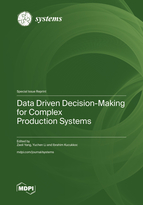Data Driven Decision-Making for Complex Production Systems
A special issue of Systems (ISSN 2079-8954). This special issue belongs to the section "Complex Systems".
Deadline for manuscript submissions: closed (30 June 2023) | Viewed by 30674
Special Issue Editors
Interests: intelligence decision support systems; expert systems and decision support; information management; artificial intelligence; fuzzy set theory; data mining; their application in various fields
Special Issues, Collections and Topics in MDPI journals
Interests: combinatorial optimization; stochastic programming; intelligent algorithm
Special Issues, Collections and Topics in MDPI journals
Interests: modelling and optimisation of modern manufacturing systems (assembly line balancing in particular); production planning of additive manufacturing machines and application of modern algorithms on sophisticated combinatorial optimisation problems
Special Issue Information
Dear Colleagues,
The complexity of production processes is increasing as technology and lifestyles change. The complexity may reside in the production system or result from characteristics or events outside the system. The former is technological complexity, which is related to the inherent complexity of the system and its technologies for both products and systems. The latter is environmental complexity, which describes the co-ordination between the system and related industries or customers, e.g., raw material supplier and retailer. The complexity poses a great challenge to the production systems. With the development of big data technology, data-driven decision-making (DDM) algorithms provide new tools and perspectives for human to further explore the complexity and uncertain problems in production systems. In particular, deep learning and artificial intelligence technologies can be used to analyze multi-source complexity factors in the production process, production planning and control systems and develop multi-source DDM algorithms accordingly, thus becoming an important way to solve the above problems. For example, the big data mining technology can be applied to extract multi-type features of each component in complex production systems, investigate the correlation between features, so as to diagnose the problems existing in complex production system. Based on multi-source features, the causal relationships between features can be constructed to identify the causes and mechanisms of problems, and the information fusion theory and comprehensive decision technology are also introduced to evaluate the performance of complex production systems, and so on.
This Special Issue aims to publish rigorous research based on the application of data driven decision-making algorithms to solve the various problems associated with complex production systems.
Potential topics include but are not limited to the following:
- Developing advanced DDM algorithms;
- DDM algorithms for real-world production planning problem;
- DDM algorithms for extracting multi-type features of complex production systems;
- Evaluating the production system performance by DDM algorithms;
- Efficient computational methods for solving new mathematical models under uncertainty;
- Emergent DDM techniques for modelling the uncertain factors;
- Identification of interaction relationships between technological complexity and environmental complexity by DDM techniques;
- Modelling dynamics of the production systems based on the DDM algorithms;
- Production system performance prediction using the DDM algorithms;
- Production system optimization modeling using the DDM algorithms.
Dr. Zaoli Yang
Dr. Yuchen Li
Dr. Ibrahim Kucukkoc
Guest Editors
Manuscript Submission Information
Manuscripts should be submitted online at www.mdpi.com by registering and logging in to this website. Once you are registered, click here to go to the submission form. Manuscripts can be submitted until the deadline. All submissions that pass pre-check are peer-reviewed. Accepted papers will be published continuously in the journal (as soon as accepted) and will be listed together on the special issue website. Research articles, review articles as well as short communications are invited. For planned papers, a title and short abstract (about 100 words) can be sent to the Editorial Office for announcement on this website.
Submitted manuscripts should not have been published previously, nor be under consideration for publication elsewhere (except conference proceedings papers). All manuscripts are thoroughly refereed through a single-blind peer-review process. A guide for authors and other relevant information for submission of manuscripts is available on the Instructions for Authors page. Systems is an international peer-reviewed open access monthly journal published by MDPI.
Please visit the Instructions for Authors page before submitting a manuscript. The Article Processing Charge (APC) for publication in this open access journal is 2400 CHF (Swiss Francs). Submitted papers should be well formatted and use good English. Authors may use MDPI's English editing service prior to publication or during author revisions.








